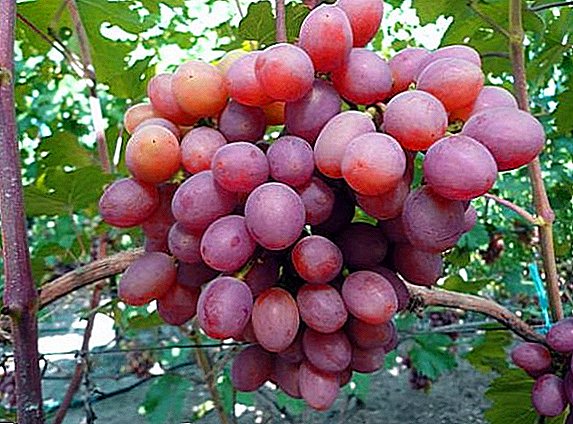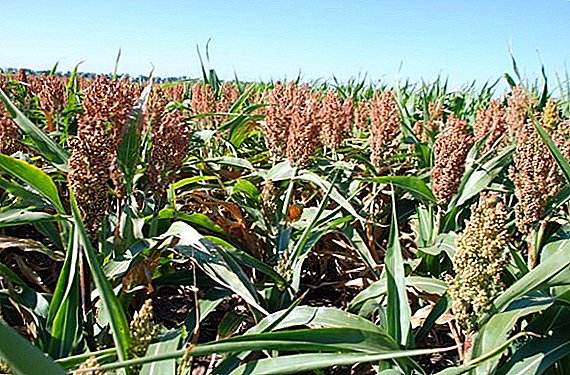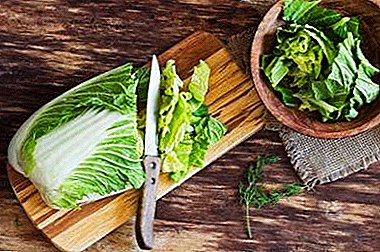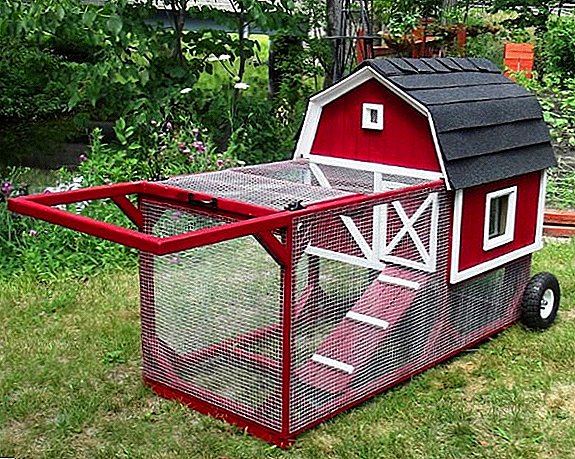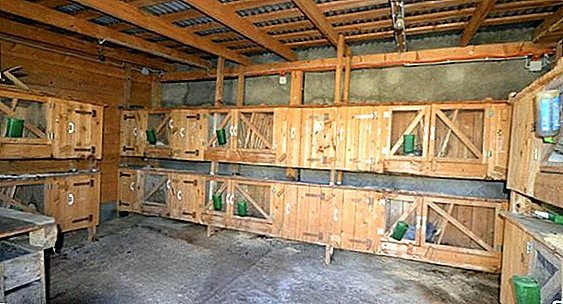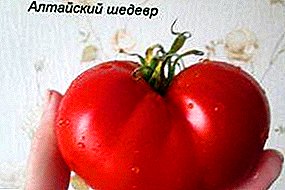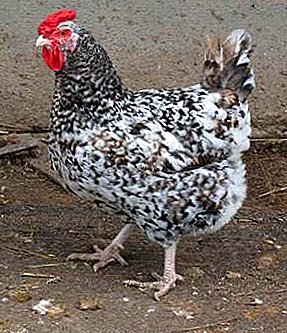
Pushkin breed of chickens belongs to the meat-egg breeds, which makes it one of the most beneficial in breeding. They were bred about two decades ago, but the breed was approved only in 2007 at the Research Institute of Genetics and Agricultural Development. animals.
The main ancestors of this breed were the hens of the black-and-white Astrolorp (meat and egg breed) and the roosters of the white Leghorn (the most egg-bearing breed in general) - these breeds are responsible for the relatively high egg-laying capacity of Pushkin hens. As for meat, the increase in the weight of chickens and roosters was achieved by directional crossing with broilers, and more specifically, with white and colored representatives of the Moscow cross-country "Broiler-6".
The results can hardly be called extremely effective, according to the meat characteristics of Pushkins, to broilers are still very far away, but the fact that Pushkin chicken meat is quite tasty is difficult to deny.
It is also worth noting that the Pushkin breed has two subspecies - bred in Sergiev Posad and in St. Petersburg. Posadskaya was bred using a smaller number of breeds, which makes it more stable, but the St. Petersburg version is more egg-bearing, although less severe. Over the past twenty years since the creation of the breed, both subspecies have repeatedly merged and again divided, so the content of this article applies to both of them, although small deviations are still possible.
Breed description Pushkinskaya
 Pushkin hens are fairly easy to distinguish by their appearance - most birds of this breed are variegated (although roosters are often white) and very high tails. The legs of the birds are also quite high, so there is no need to worry about their “patency” - Pushkin's chickens easily walk even on very tall grass.
Pushkin hens are fairly easy to distinguish by their appearance - most birds of this breed are variegated (although roosters are often white) and very high tails. The legs of the birds are also quite high, so there is no need to worry about their “patency” - Pushkin's chickens easily walk even on very tall grass.
The head of the hens is slightly elongated, but it looks organically together with a sharply curved down middle length of the beak and a high comb of bright pink color. There is a spike on the ridge, and a rather pronounced one. The earlobes are also pink, but can sometimes be white-pink or completely white. The eyes of birds are usually orange, but they are not spelled out in the standard of the breed, so they cannot serve as a criterion for evaluation. The neck is high, with obvious signs of a mane.
Chickens of this breed are rather small - only a couple of kilograms, but roosters grow up to three. Moreover, the meat itself is quite tasty. Chickens carry about 220 eggs per year, but there is information about higher volumes, up to 270-290 eggs per year. What is interesting - in the first year of their life, they rush much more actively than in the following years.
The color of eggs is white or light cream, the mass of eggs is 58 grams. The percentage of fertilized eggs exceeds 90%that allows you to quickly breed these chickens. Relatively early growing up also helps this - on the 165th day of life the hen is ready to bring offspring.
 Fawn Brahma, in principle, like all types of Bram, are very popular in Russia due to their unpretentious nature and high performance.
Fawn Brahma, in principle, like all types of Bram, are very popular in Russia due to their unpretentious nature and high performance.
Mushroom cultivation can be very profitable. For information on how to do this correctly, read here.
The survival rate of chicks also exceeds 90%, but at a more mature age, for various reasons, up to 12% of the livestock die - mainly because of the diseases to which these chickens are still a bit susceptible.
Chickens themselves do not know how to fly - and therefore are considered the most preferable for farmers who do not keep their chickens in cages, but are released into open enclosures. In general, according to meat and egg characteristics, this breed is almost ideal for a small farm, which wants to produce high-quality and tasty eggs in large volumes, but it does not want to lose in meat production.
A photo
In this section of the article you can see these birds more clearly. The very first photo shows Pushkin's striped and motley breed of chickens:
And here you see a large number of individuals in a fairly large chicken coop:
Motley chickens eat grass in the yard:
And here is a picture of a chicken farm, where each breed of chickens is separated from another:
A wonderful photo of two individuals of our breed in winter on the steps of the house:
Pushkinsky hens and roosters while walking near the house:
And, of course, beautiful chickens that have recently hatched:
Cultivation and maintenance
 Actually, there are no particular features in the cultivation and breeding of these chickens - they are extremely calm and unpretentious. Mainly due to proper breeding - both ancestor breeds are also almost perfectly adapted to Russian conditions.
Actually, there are no particular features in the cultivation and breeding of these chickens - they are extremely calm and unpretentious. Mainly due to proper breeding - both ancestor breeds are also almost perfectly adapted to Russian conditions.
In feeding birds extremely unpretentious and therefore it is possible not to buy extremely expensive feeds and get along with grain and simple feed (it is better to give each day both, but at different times). Feeding birds costs about twice a day, but if you prefer to give them small doses, you can feed them more often.
Chickens do not require special housing conditions - it is enough to have a relatively warm room and a roof over your head. And the main stake was made on frost resistance - already the chickens calmly walk under the open sky. And the embryos are quite adapted to tough conditions and are quietly grown in incubators, even after a couple of days without laying. Although, this is already a matter of luck and it is not recommended to do it all the time.
There will definitely be no problems with relationships in the hen house - roosters of this breed are able to manage a fairly large "harem"up to 20-25 chickens. But if the "wives" sultans of the chicken coop is not enough, then there may be clashes and fights between birds. The ideal option is the resettlement of roosters in different hen-houses and sending those who did not get any chickens to meat.
 The main problems of breeding Pushkin hens are connected, oddly enough, with the purchase of chickens. The fact is that neither the purchase of chickens in a factory or a chicken farm, nor the purchase of chickens from any peasant farmsteads, gives a guarantee of quality.
The main problems of breeding Pushkin hens are connected, oddly enough, with the purchase of chickens. The fact is that neither the purchase of chickens in a factory or a chicken farm, nor the purchase of chickens from any peasant farmsteads, gives a guarantee of quality.
In the first case, you can get just the factory, which means nervous and stress-resistant chicks, which, despite belonging to this breed, will be badly born and have tasteless meat due to an excess of stress. In the second you can get unbreeding chickens.
Actually, the second case is preferable - even an unclean Pushkin breed has excellent characteristics, besides, some hybrids are even better than purebred chickens. However, if you want to do the selection yourself, this can be a problem.
Where can I buy in Russia?
 Pushkinsky chickens can be purchased on most poultry farms in the Russian Federation, which generally raise chickens, but in most cases, chickens are raised there under factory conditions. If this does not scare you - just contact any search resource with the corresponding request and get to the website of the chicken farm.
Pushkinsky chickens can be purchased on most poultry farms in the Russian Federation, which generally raise chickens, but in most cases, chickens are raised there under factory conditions. If this does not scare you - just contact any search resource with the corresponding request and get to the website of the chicken farm.
But when you buy chickens or eggs from your hands you will have to sweat, looking for contacts of people willing to share them. We advise you to go through large forums of poultry farmers, for example, already odious, but still quite lively //www.pticevody.ru/. In the old and new topics of this forum there are a lot of contact details for both breeders of common production breeds of chickens and the most decorative and rare birds. True, the data could have become outdated for a long time, and the people themselves could change their hobby, but the attempt is not torture, is it? This topic is relatively alive: //www.pticevody.ru/t1214p100-topic, you can start with it.
If you do not want to spend time searching, you can use a small list of sellers already found by us:
- +7 (921) 932-34-44, Poultry Farm "Farm +", Gatchina, Leningrad Region.
- +7 (918) 216-10-90, Poultry Farm "Chicken Courtyard", Apsheronsk, Krasnodar Territory.
- +7 (928) 367-77-82, Evgenia. Sending across Russia.
 Chicken Maran breed is famous for the fact that it carries chocolate-colored eggs.
Chicken Maran breed is famous for the fact that it carries chocolate-colored eggs.
If you want to know how to properly maintain, feed and breed quails, then you should read this article.
Analogs
There are quite a few analogs of the breed, but most of them lag behind it in at least one of the important parameters. First of all, it is worth mentioning her ancestors - Astrolorp and Leggorn. However, the first is not so cold-resistant and much worse rush. And the latter are generally not meat breed.
Similar in characteristics breed are kura-GalansAlso called black bearded chickens. However, there is another factor here - nobody breeds industrial Galans and the egg of this rather rare breed can be found only among enthusiasts. In addition, Galana is rather a meat breed, not an egg, because the body weight increased to 3–4 kg must be paid by reducing egg production to 180–200 eggs per year.
Also, the Orlovskie chickens can compete with the Pushkin hens - another product of Russian selection, but this time older, inherited from the Russian Empire. They also have a higher body weight, and the chickens themselves look somewhat more massive, but they carry very few eggs - about 150 pieces a year, which is unacceptable for an egg breed. Yes, and their nature does not go to any comparison with calm Pushkin.
Conclusion
 Before we summarize, I would like to mention that this breed was bred relatively recently and therefore still has potential for improvement. However, it is hardly possible at all - chickens already possess all the skills they need. They are extremely frost-resistant, tenacious, have a rather large mass, often rush and, most importantly, are not prone to clashes and shoots. However, some quite simple conditions are still required to be observed - in particular, those that were indicated a little higher.
Before we summarize, I would like to mention that this breed was bred relatively recently and therefore still has potential for improvement. However, it is hardly possible at all - chickens already possess all the skills they need. They are extremely frost-resistant, tenacious, have a rather large mass, often rush and, most importantly, are not prone to clashes and shoots. However, some quite simple conditions are still required to be observed - in particular, those that were indicated a little higher.
At all, Pushkin's chickens are almost the ideal solution for any average farmer. Yes, and private owners will certainly want to try to start such an unpretentious and very useful bird, which proves the huge number of fans of Pushkin hens both in Russia and abroad. In addition, the selection potential is perfect for experimenters who want to impress the world with the results of their work.
In general, there will be no problems with buying and breeding a breed, so go ahead and you! Believe me, Pushkin's chickens are one of the best breeds on the Russian market.


